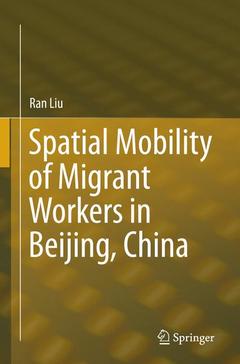Description
Spatial Mobility of Migrant Workers in Beijing, China, 2015
Author: Liu Ran
Language: English
Subjects for Spatial Mobility of Migrant Workers in Beijing, China:
Publication date: 10-2016
Support: Print on demand
Publication date: 04-2015
303 p. · 15.5x23.5 cm · Hardback
Description
/li>Contents
/li>Comment
/li>
The great migration of farmers leaving rural China to work and live in big cities as 'floaters' has been an on-going debate in China for the past three decades. This book probes into the spatial mobility of migrant workers in Beijing, and questions the city 'rights' issues beneath the city-making movement in contemporary China. In revealing and explaining the socio-spatial injustice, this volume re-theorizes the 'right to the city' in the Chinese context since Deng Xiaoping's reforms. The policy review, census analysis, and housing survey are conducted to examine the fate of migrant workers, who being the most marginalized group have to move persistently as the city expands and modernizes itself. The study also compares the migrant workers with local Pekinese dislocated by inner city renewals and city expansion activities. Rapid urban growth and land expropriation of peripheral farmlands have also created a by-product of urbanization, an informal property development by local farmers in response to rising low-cost rental housing demand. This is a highly comparable phenomenon with cities in other newly industrialized countries, such as São Paulo. Readers will be provided with a good basis in understanding the interplay as well as conflicts between migrant workers' housing rights and China's globalizing and branding pursuits of its capital city.
Audience:
This book will be of great interest to researchers and policy makers in housing planning, governance towards urban informalities, rights to the city, migrant control and management, and housing-related conflict resolutions in China today.
1. China’s Globalizing Primary Cities as a Contested Space: An Introduction
1.1. Introduction
1.2. Background: The City-Making Movement and Housing Inequality in China
1.3. What This Book is About
1.4. Research Methodologies and Contexts
1.5. Organization of This Book: Chapters
Part I Understanding the Spatial Mobility of China’s Migrant Workers against a Backdrop of City-Branding Movements
2. The Intra-City Residential Mobility of Migrant Workers: A Literature Review
2.1. Introduction
2.2. Intra-City Residential Mobility in Advanced Economies
2.3. Mobility of Rural Migrants and their Urban Informalities in Third World Cities
2.4. Mobility of Rural Migrants in Urbanizing China
2.5. Weber, Harvey and Lefebvre’s Theories of Socio-Spatial Mobility and the Notion of the ‘Right’
2.6. Brief Summary: Bridging the Research Gaps between Western Theories and China Studies
3. Conflict between City Image Pursuits and Migrant Workers’ Rights
3.1. Background: The Transition from a Command to a Market Economy
3.2. Developmental Urbanism versus Inequitable Access to City Rights
3.3. The Perceived Unjust Mobility Policies
3.4. Re-Theorizing the ‘Right to the City’ in the Chinese Context
3.5. Conclusion
Part II Spatial Mobility of Migrant Workers in Globalizing Beijing, 2000-2010
4. Demographic Profile, Spatial Mobility and Residence of Migrants in Beijing: Data from the 2010 Census
4.1. Introduction
4.2. Demographic Profile of Beijing’s Migrants in 2010
4.3. The In-Migration of Beijing’s Migrants in 2010
4.4. Spatial Distribution of Migrants in Beijing from 2000 to 2010
4.5. The Residence of Migrants in Beijing’s Rural Areas in the 2000s
4.6. The Beijing Municipality’s Governance Practices towards Migrant Workers and their Informal Housing
4.7. Conclusion: ‘Right to the City’ of Migrants Compromised in Beijing’s Governance System
5. Low-Wage Migrants in North-Western Beijing: The Precarious Tenancy and Floating Life
5.1. Introduction
5.2. The Hukou System: An Invisible Wall Depriving Migrants of their ‘Rights’ to the City?
5.3. Survey Methodology
5.4. Survey Findings
5.5. Evaluation of Gain and Loss following Mobility
5.6. The Mobility Gaps between Various Social Groups
5.7. Discussion: Housing ‘Illegality’ and Demolition
5.8. Conclusion
6. The Marginalized Status of Dislocated Migrant Groups in Beijing
6.1. Introduction
6.2. Housing and Redevelopment Policies in Beijing: A Review
6.3. Comparing Dislocated Migrant Workers and Local Dislocated Groups in Beijing
6.4. Mechanisms of Spatial Mobility of Low-Income Residents in Beijing
6.5. Conclusion
Part III City Governance towards Urban Informalities in Different Urbanization Contexts
7. Building the Globalizing City with or without Slums? — Exploring the Contrast between City Models in São Paulo and Beijing
7.1. Introduction
7.2. ‘Overurbanization’ versus ‘Underurbanization’ in Rapidly Industrializing Areas
7.3. Land in Urban China: A Source for Financing Rapid and Formal Urbanization
7.4. Exigencies Produced by the Lefebvrian Notion of the ‘Right to the City’
7.5. Conclusion
8. Conclusion: Exigencies Produced by the Lefebvrian Notion of ‘Right to the City’
8.1. Summary of Findings
8.2. Originality and Contributions of this Book
8.3. Findings Drawn from Research on China’s Urbanization Mode
8.4. Conclusion: ‘Right’ and ‘Mobility’ Relations in Contemporary China
Appendix I: Beijing Urban Village Survey Questionnaire (English Version)
Appendix II: Beijing Urban Village Survey Questionnaire (Chinese Version)
Index
Highlights the migrant workers’ housing rights in China’s primary cities and includes also cases studies from Latin America and India
Written from a human-rights-orientated perspective and space-citizenship dialectics
Covers a wide range of practice areas of migration control in China today, from its hukou system to Beijing Municipality’s style of governance towards urban informalities

